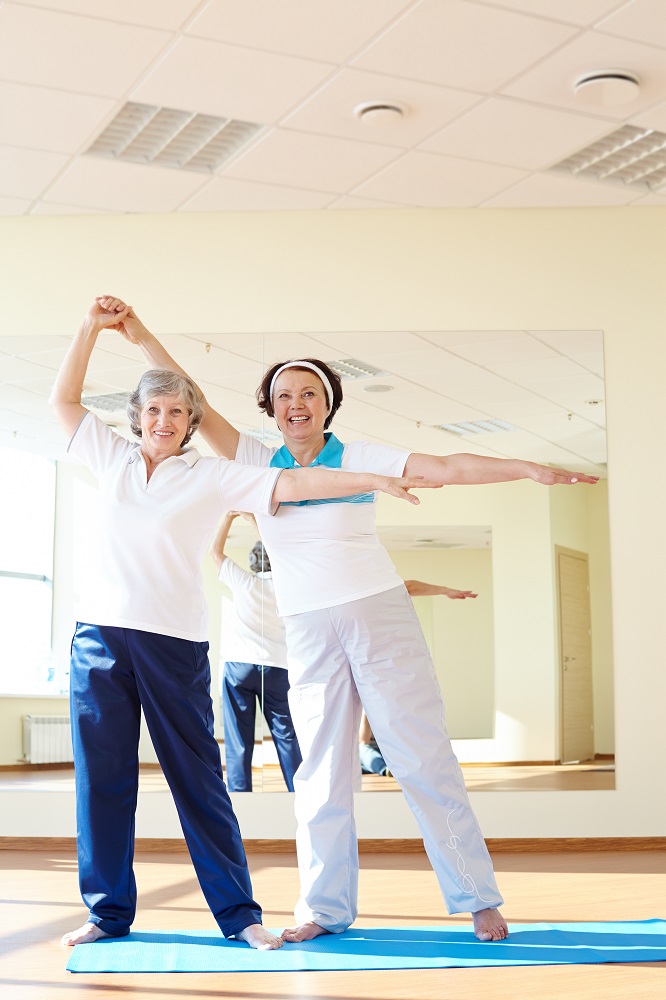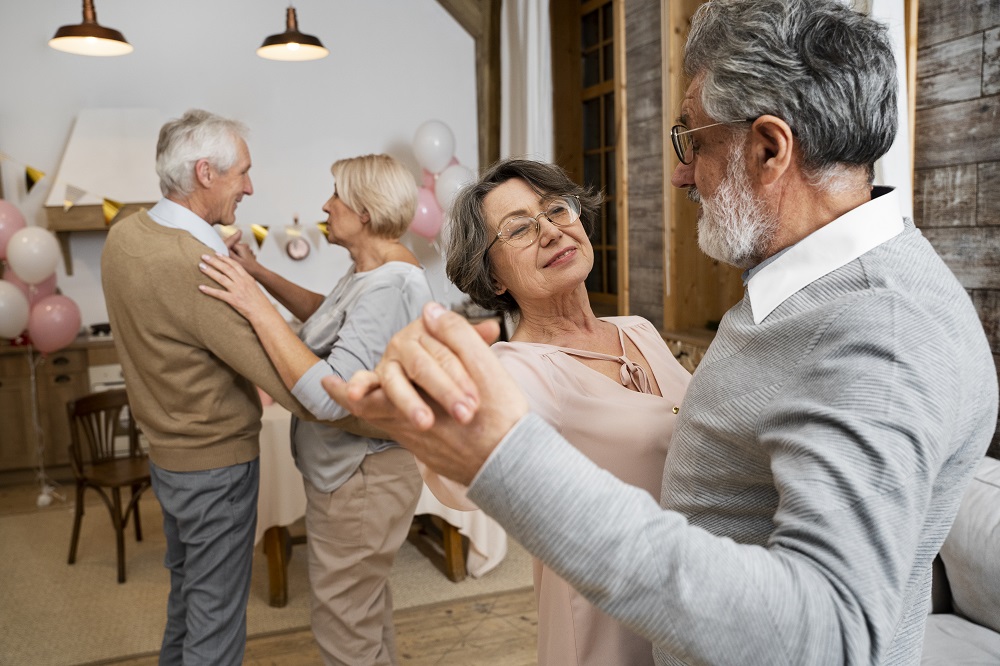«You are the dancing queen!» – how dancing promotes healthy aging
While the Roman orator Cicero classified dancing as “mad” (perhaps with a twinkle in his eye), today we intuitively know about the numerous positive effects – and not just at a young age. Dancing knows no age, as demonstrated by the numerous dance events or the idea of “dancing while seated”. However, scientific study results also underline this: Dancing is not at all crazy, but extremely reasonable, as it contributes to healthy ageing. We have compiled some of the positive effects here.
No one dances sober unless he is insane.
Marcus Tullius Cicero (106 – 43 v. Chr.), Roman speaker and statesman
Dancing as a physical activity
The music is turned on, perhaps your favorite song is playing, and the movements come naturally. All the tiredness disappears, one step follows the next, “the dancing leg is swung”. Plus, you get a fitness workout along the way. Australian participants in ballet classes for senior citizens report, for example, that they feel more energized and in shape, that they feel good about their bodies and that their balance and flexibility improve (Ali-Haapala et al., 2018). These subjective impressions can also be objectively verified with tests. For example, researchers in Greece have been able to show that older people who have taken part in traditional Greek dance lessons have greater endurance, increased hand strength, improved balance on one leg and also find it easier to stand up (Douka et al., 2019). These positive findings have also stimulated research into fall prevention, for example, as can be read impressively on the homepage of the SturzZentrum Schweiz. Dancing as a physical activity can therefore contribute to being and staying in better physical health. And if your body starts to ache after training, then at least we know why, as some dance course participants describe it:

ROBYN I’ll tell you what I like is if the next morning. I get out of bed and think, “Oo, that’s a little bit of a twingy.”
CHRISTINE “That hurts.” Laughs.
ANNE Oo, yes. Laughs. That’s right.
ROBYN “The old calves are a bit tight on that one.” And you just think, “That was ballet yesterday. Great. That means I’ve moved by body.”
CHRISTINE Yes.
ROBYN My body’s moving properly.
ANNE Yes, that’s it. [. . .]
ROBYN But it feels good that you’ve actually used your body.
The effects of dancing on emotional well-being
Emotional well-being describes feelings such as contentment, optimism, positive emotions and the absence of negative emotions. Perhaps everything we feel after a successful dance evening! At least that’s how the dancers from Ballet Queensland describe it. Dancing makes them feel in a better mood, they feel more balanced and negative feelings no longer carry as much weight (Ali-Haapala et al., 2018). Good emotional well-being also has an effect even after the music has stopped. Scientists have found that our well-being affects the length of our lives and that good well-being can contribute to us reaching an older age – but emotional well-being and all its effects on health, for example, are too complex to answer the question of whether it is 4 years or 10 years (Diener & Chan, 2011). But that is not enough. For example, there have been some attempts to see whether dancing as a non-drug form of treatment can reduce the symptoms of depression. Again, there are many facets to consider, but in some studies, depression was actually improved with the help of dancing (Rittiwong et al., 2023). The significance of this finding can be imagined when you consider that depression is the most common mental illness in old age (Amrhein, 2013).
Wherever the dancer steps with his (her) foot, a source of life springs from the dust.
Dschalal ad-Din Muhammad Rumi (1207 – 1273)
Dancing as a social experience
Come on and give me this dance, put your hand in my hand, leave the music on!
From a song lyric by „Madsen“, German rock band

This is how it sounds in the lyrics of a song with a great melody and driving beats – there’s almost nothing left to do but grab your hand and dance. Dancing is a social experience – and not just for couples. Participants in solo dance forms such as ballet also describe how the meetings create a sense of community; they are connected through the music and the dance, feel the energy and share their passion with each other. And perhaps even new friendships are formed as a result. However, in order for dancing to be perceived as a positive, social experience, the conditions must also be right: no pressure or competition, an open and friendly atmosphere, a humorous, non-judgmental approach to possible mistakes, a willingness to help, a good pace, time to exchange ideas and so on… (Ali-Haapala et al., 2018; Douka et al., 2019). Fortunately, there are many opportunities to dance in Switzerland, which increases the likelihood of finding a group in which you feel comfortable. If you also feel like joining a dance group, take a look at our three suggestions at the end of the article.
Effects of dancing on cognition
It is a well-known saying that physical activity is also good for the head. In the case of dancing, there really is something to it. This is mainly due to the fact that dancing has many facets:
- pure physical movement with endurance, coordination and balance,
- learning new movement patterns and remembering old ones,
- the accompanying music that stimulates the senses,
- and a possible emotional and social well-being.

All of this might lead to memory not deteriorating or even improving (Müller et al., 2017; Predovan et al., 2019). In a study in which participants aged 63 and over took part in either a sports group or a dance group for 18 months, everyone’s attention and memory improved. But, in the dance group, new gray cells even formed in the brain. The researchers concluded that long-term participation in a dance program is superior to simple physical exercise (Müller et al., 2017). But how can improved well-being through dancing have a positive effect on memory? Depression has a negative effect on memory, and if dancing helps to alleviate symptoms of depression, it leads to an improvement in memory performance (Predovan et al., 2019).
How dancing promotes memory
Perhaps you immediately thought of the melody and the first lyrics of the ABBA disco classic when you read the title of this article: “You are the dancing queen, young and sweet, only seventeen!”. Or perhaps your favorite song is your favorite song because you associate a beautiful memory with it. Music serves as a trigger and often uses memories to create a good feeling. At the same time, our body stores many movement patterns – and if you took part in a dance course when you were young like so many others, you may be surprised at how automatically you can dance the dance steps you once learned with little reminders (Coaten, 2001).
Conclusion
Thanks to its holistic nature, dancing can contribute to healthy ageing and a good sense of well-being. Because dancing combined with music promotes physical activity, the experience of positive emotions, it is memory and recall training and can be the basis for social interaction.
If you’ve now caught the dance fever, here are three platforms in Switzerland where you can find offers to dance or join in:
- Everdance® is a solo dance concept for the 60+ target audience. It combines dance steps from couple dancing with additional movement elements. You can find numerous locations on the homepage.
- Pro Senectute offers numerous dance courses and dance afternoons (including Everdance®) throughout Switzerland. Offers can be filtered via the calendar of events. Here you will also find online offers that invite you to dance along at home via video conferencing.
- In the Tanzkalender you will also find countless dance events for couple dances in the afternoon and evening in German-speaking Switzerland and especially around Zurich.

References
Ali-Haapala, A., Moyle, G. & Kerr, G. (2018). Ballet Moves for Adult Creative Health: Stae One – Research Report.
Amrhein, C. (2013). Psychische Störungen im Alter.
Coaten, R. (2001). Exploring reminiscence through dance and movement. Journal of Dementia Care(Sept/Oct), 19–22.
Diener, E. & Chan, M. Y. (2011). Happy People Live Longer: Subjective Well-Being Contributes to Health and Longevity. Applied Psychology: Health and Well-Being, 3(1), 1–43.
Douka, S., Zilidou, V. I., Lilou, O. & Manou, V. (2019). Traditional Dance Improves the Physical Fitness and Well-Being of the Elderly. Frontiers in aging neuroscience, 11, 75.
Müller, P., Rehfeld, K., Schmicker, M., Hökelmann, A., Dordevic, M., Lessmann, V., Brigadski, T., Kaufmann, J. & Müller, N. G. (2017). Evolution of Neuroplasticity in Response to Physical Activity in Old Age: The Case for Dancing. Frontiers in aging neuroscience, 9, 56.
Predovan, D., Julien, A., Esmail, A. & Bherer, L. (2019). Effects of Dancing on Cognition in Healthy Older Adults: a Systematic Review. Journal of Cognitive Enhancement, 3(2), 161–167.
Rittiwong, T., Reangsing, C. & Schneider, J. K. (2023). The Effects of Dance Interventions on Depression in Older Adults: A Meta-Analysis. Journal of Applied Gerontology, 9, 42.
The images used are from www.freepik.com and https://ageingbetter.resourcespace.com
